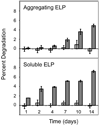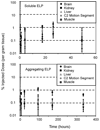An injectable and in situ-gelling biopolymer for sustained drug release following perineural administration
- PMID: 18379401
- PMCID: PMC2736879
- DOI: 10.1097/BRS.0b013e3181695773
An injectable and in situ-gelling biopolymer for sustained drug release following perineural administration
Abstract
Study design: This study evaluated whether the aggregation behavior of a thermally responsive elastin-like polypeptide (ELP) prolongs protein residence time at the dorsal root ganglion (DRG). This work involves development of a sustained-release drug delivery vehicle to provide high and sustained levels of biologic therapeutics to the dorsal root ganglion while minimizing systemic exposure.
Objective: To study the potential of the ELP biopolymer to sustain release and lower systemic exposure of bioactive peptides following perineural administration.
Summary of background data: Anticytokine treatment for lumbar radiculopathy may offer clinical improvement, but exposes patients to systemic toxicities of immunosuppression. ELPs are environmentally responsive polypeptides that undergo a phase transition on heating to form an insoluble aggregate. Drug conjugates with ELP exhibit both temperature-sensitivity and in vitro bioactivity. Monomer resolubilization yields solution-phase molecules, and this reversible aggregation behavior may create a perineural drug depot to sustain drug delivery to an inflamed nerve.
Methods: This experiment involved 48 rats in which radiolabeled ELPs (aggregating or soluble) were injected overlying the L5 dorsal root ganglion. Animals were killed at 6 different time points, and radioactivity associated with the injected segment, serum, and other tissues was evaluated.
Results: The aggregating ELP demonstrated a 7-fold longer perineural half-life compared with the soluble ELP. This supports the hypothesis that the aggregating ELP forms a depot from which slow resolubilization and clearance provides sustained, local protein release. Furthermore, serum radioactivity reached a lower peak for the aggregating group, demonstrating slower absorption of the aggregating protein into the systemic circulation.
Conclusion: These results suggest that ELP aggregation confer the benefit of perineural compartment longevity for bioactive therapeutics delivered fused with this carrier. This may sustain release of potent immunomodulator therapeutics to treat local neuroinflammation. Desirable features include delivery of high local doses and protection against systemic exposure and associated toxicity.
Figures




References
-
- Olmarker K, Storkson R, Berge OG. Pathogenesis of sciatic pain: a study of spontaneous behavior in rats exposed to experimental disc herniation. Spine. 2002;27:1312–1317. - PubMed
-
- Winkelstein BA, Weinstein JN, DeLeo JA. The role of mechanical deformation in lumbar radiculopathy: an in vivo model. Spine. 2002;27:27–33. - PubMed
-
- Hashizume H, DeLeo JA, Colburn RW, et al. Spinal glial activation and cytokine expression after lumbar root injury in the rat. Spine. 2000;25:1206–1217. - PubMed
-
- Aoki Y, Rydevik B, Kikuchi S, et al. Local application of disc-related cytokines on spinal nerve roots. Spine. 2002;27:1614–1617. - PubMed
-
- Igarashi T, Kikuchi S, Shubayev V, et al. Volvo Award winner in basic science studies: exogenous tumor necrosis factor-alpha mimics nucleus pulposus-induced neuropathology. Molecular, histologic, and behavioral comparisons in rats. Spine. 2000;25:2975–2980. - PubMed
Publication types
MeSH terms
Substances
Grants and funding
LinkOut - more resources
Full Text Sources
Research Materials

